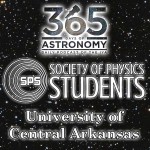Podcaster: Dr. Meg Rosenburg
 Title: Craters in Context: Science and History of Impact
Title: Craters in Context: Science and History of Impact
Organization: The Society of Physics Students (SPS) at The University of Central Arkansas
Link : The Society of Physics Students (SPS) at The University of Central Arkansas
This is a short (2-minute) video I made, originally as part of my thesis defense, to introduce the impact process:https://www.youtube.com/watch?v=fM3yxyzJJ3I
Here’s an introduction to impact cratering and crater morphology (shape characteristics) from the Lunar and Planetary Institute:http://www.lpi.usra.edu/exploration/education/hsResearch/crateringLab/lab/part1/background/
Over at CosmoQuest, the MoonMappers project enlists the public to help out with crater counts on the Moon: http://cosmoquest.org/?application=simply_craters
Description:Everywhere we look in the solar system, from our own Moon to Mars to the icy satellites of the outer planets, there are surfaces covered in impact craters. Today, we understand these holes in the ground to be remnants of cosmic collisions, an extremely common (if rather violent) process, and impact is how we make sense of a whole host of observations. Cratered terrains provide a basis for understanding the timing of events on a planetary surface, and these events can even be correlated between planets. Analysis of the sizes of impact craters can also potentially tell us which population of objects caused them in the first place, which puts constraints on dynamical models of solar system formation.
Bio: The Society of Physics Students (SPS) at The University of Central Arkansas is incorporates outreach, demonstrations, tutoring and guest speakers into our SPS Chapter.
Dr. Meg Rosenburg is a freelance science communicator, content producer, and independent scholar based in the Boston area. In 2014, she earned her Ph.D. from Caltech in Planetary Science, with an extra focus in the history of science, and she’s especially interested in impact craters on the Moon and Earth, their contribution to planetary topography, and how they have been interpreted over the centuries.
Today’s sponsor: This episode of “365 Days of Astronomy” is sponsored by — no one. We still need sponsors for many days in 2016, so please consider sponsoring a day or two. Just click on the “Donate” button on the lower left side of this webpage, or contact us at signup@365daysofastronomy.org
End of podcast:
365 Days of Astronomy
=====================
The 365 Days of Astronomy Podcast is produced by Astrosphere New Media. Audio post-production by Richard Drumm. Bandwidth donated by libsyn.com and wizzard media. You may reproduce and distribute this audio for non-commercial purposes. Please consider supporting the podcast with a few dollars (or Euros!). Visit us on the web at 365DaysOfAstronomy.org or email us at info@365DaysOfAstronomy.org. This year we will celebrate more discoveries and stories from the universe. Join us and share your story. Until tomorrow! Goodbye!

